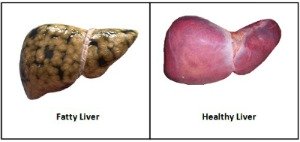Fatty Liver Disease
Fatty Liver Disease doesn’t just target people who abuse alcohol, In fact this disease can be broken down into two categories, alcoholic and non-alcoholic causes.

Proper liver function is an absolute necessity to maintain our health. It is your body’s hardest working organ and has many functions to ensure your survival. It filters, eliminates and neutralizes everything that you put in your body, and I mean everything. Everything we eat, drink, inhale or absorb through our skin.
So what does it mean to have a fatty liver?
Just as the name implies this condition exists when there is excess fat accumulated in the liver cells. This happens when we consume more fats than our bodies can properly break down and over time the cells become fatty making them less healthy. When this vital organ becomes 5 – 10 percent comprised of fatty cells, you have this condition.
Even though alcohol is truly a destructive force to this vital organ the most common cause of this condition is obesity. This doesn’t sound right does it? But the simply reality is that there are more people who struggle with obesity than alcohol abusers.
For many people this disease is not serious but over time the liver can become more vulnerable to further damage such as inflammation, cirrhosis, liver failure and sometimes even death.
Of course the damage of this organ will vary greatly depending on what is causing stress on the organ. For instance heavy alcohol and drug abuse usually creates graver consequences and a lack of healthy foods is also a great contributor.
Alcoholic Liver Disease (ALD)
When alcohol is consumed in large quantities, abused or overused the chances of developing a fatty liver can be as high as 90 – 100 percent. Of course lots of things play a role such as genetics and how often and how much a person drinks.
Non-alcoholic fatty liver disease (NAFLD)
As the name implies, this condition can affect even those people who don’t consume alcohol. NAFLD is becoming more common for one reason, because obesity is becoming more widespread.
Overeating has become a popular past time and unhealthy processed foods are fueling the fire. Though NAFLD usually is not a serious condition it can lead to more serious issues such as inflammation or scarring of the liver.
Non-alcoholic steatohepatisits (NASH)
This disease is similar to alcoholic liver disease but surprisingly enough strikes people that drink very little or no alcohol at all. It can lead to permanent damage of the liver including scarring of the tissue, cirrhosis and in worst cases liver failure and death.
The cause of NASH remains a mystery but seems more frequent in people who battle with obesity and diabetes. Also NASH has no warning signs or symptoms and is usually discovered during a liver biopsy.
Some Causes of Fatty Liver Disease May Include:
- Obesity
- Alcohol
- High cholesterol
- Diabetes
- Intestinal by-pass surgery
- Certain medications such as corticosteroids, tetracycline, carbon tetrachloride and immune suppressing medications
- Viral hepatitis
- Genetics
Signs and Symptoms of ALD:
- Yellowing of the eyes and skin, a condition known as jaundice
- Water retention
- Internal bleeding
- Muscle weakness
- Liver Failure
Signs and Symptoms of NAFLD:
It usually takes years before any symptoms appear.
- Swollen legs and feet
- Weight loss
- Loss of appetite
- Fatigue
- Feeling Weak
- Trouble concentrating, confusion
- Pain in upper right abdomen
- Yellowing of the skin or eyes
- Darker colored urine
Prevention:
Substitute healthier foods in place of fast, processed, deep fried or sugary foods whenever possible.
Daily exercise (even as little as 20 minutes a day) can make a big difference over time.
Detox your body on occasion and try to reduce toxins from your diet such as alcohol and junk food and any other unnecessary toxins such as nicotine.
For people with diabetes or high cholesterol – take extra care to keep these conditions well controlled.
How do you know if you have fatty liver disease?
A routine check up at your doctor’s office is a great start. Doctors may use some of the following procedures for diagnoses.
- Physical exam
- Blood tests
- Ultra sound
- Liver biopsy
Treatments:
In most cases a person knows exactly what needs to be done. If you are a heavy drinker stop drinking. If obesity is the cause then a healthier diet with gradual weight loss is needed.
If your condition is severe only you and your physician can figure out what steps you must take next. For patients with cirrhosis of the liver a transplant may be needed.
Of course prevention is always the best way to avoid more serious health issues from developing.
Wishing you health and happiness
Return from Fatty Liver Disease to Liver Function
Return to Healthy Weight Loss Help
New! Comments
Have your say about what you just read. Leave us a comment in the box below.